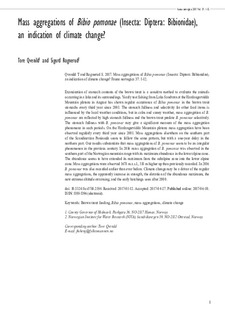| dc.contributor.author | Qvenild, Tore | |
| dc.contributor.author | Rognerud, Sigurd | |
| dc.date.accessioned | 2018-08-02T10:48:29Z | |
| dc.date.available | 2018-08-02T10:48:29Z | |
| dc.date.created | 2018-02-23T13:02:53Z | |
| dc.date.issued | 2017 | |
| dc.identifier.citation | Fauna Norvegica. 2017, 37, 1-12. | nb_NO |
| dc.identifier.issn | 1502-4873 | |
| dc.identifier.uri | http://hdl.handle.net/11250/2507257 | |
| dc.description.abstract | Examination of stomach contents of the brown trout is a sensitive method to evaluate the animals occurring in a lake and its surroundings. Yearly test fishing from Lake Sandvatn at the Hardangervidda Mountain plateau in August has shown regular occurrence of Bibio pomonae in the brown trout stomachs every third year since 2001. The stomach fullness and selectivity for other food items is influenced by the local weather conditions, but in calm and sunny weather, mass aggregation of B. pomonae are reflected by high stomach fullness and the brown trout predate B. pomonae selectively. The stomach fullness with B. pomonae may give a significant measure of the mass aggregation phenomena in such periods. On the Hardangervidda Mountain plateau mass aggregation have been observed regularly every third year since 2001. Mass aggregations elsewhere on the southern part of the Scandinavian Peninsula seem to follow the same pattern, but with a one-year delay in the northern part. Our results substantiate that mass aggregations of B. pomonae seem to be an irregular phenomenon in the previous century. In 2016 mass aggregation of B. pomonae was observed in the southern part of the Norwegian mountain range with its maximum abundance in the lower alpine zone. The abundance seems to have extended its maximum from the subalpine zone into the lower alpine zone. Mass aggregations were observed 1678 m a.s.l., 318 m higher up than previously recorded. In 2016 B. pomonae was also recorded earlier than ever before. Climate change may be a driver of the regular mass aggregations, the apparently increase in strength, the elevation of the abundance maximum, the new extreme altitude swarming, and the early hatchings seen after 2000. | nb_NO |
| dc.language.iso | eng | nb_NO |
| dc.publisher | NTNU Open Access Journals | nb_NO |
| dc.rights | Navngivelse 4.0 Internasjonal | * |
| dc.rights.uri | http://creativecommons.org/licenses/by/4.0/deed.no | * |
| dc.title | Mass aggregations of Bibio pomonae (Insecta: Diptera: Bibionidae), an indication of climate change? | nb_NO |
| dc.type | Journal article | nb_NO |
| dc.type | Peer reviewed | nb_NO |
| dc.description.version | publishedVersion | nb_NO |
| dc.rights.holder | The Authors. | nb_NO |
| dc.source.pagenumber | 1-12 | nb_NO |
| dc.source.volume | 37 | nb_NO |
| dc.source.journal | Fauna Norvegica | nb_NO |
| dc.identifier.doi | 10.5324/fn.v37i0.2194 | |
| dc.identifier.cristin | 1568290 | |
| dc.relation.project | Miljødirektoratet | nb_NO |
| dc.relation.project | Laagefjeld AS | nb_NO |
| cristin.unitcode | 7464,30,12,0 | |
| cristin.unitname | Akvatiske miljøgifter | |
| cristin.ispublished | true | |
| cristin.fulltext | original | |
| cristin.qualitycode | 1 | |

